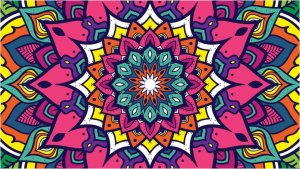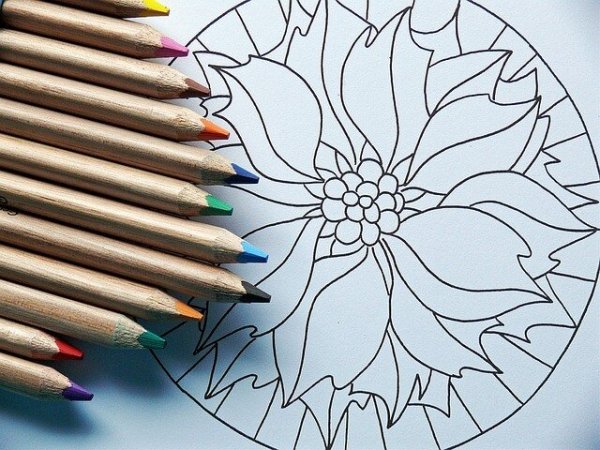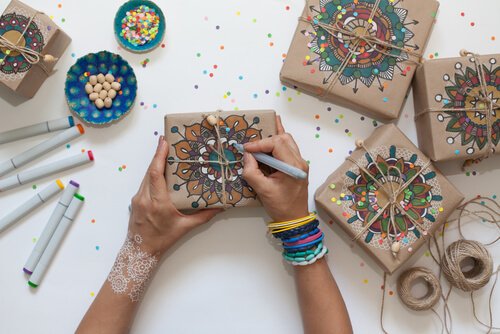5 Benefits of Mandalas


Written and verified by the psychologist Sergio De Dios González
The world mandala comes from Sanskrit, and it means “sacred circle.” Mandalas are circular symbols that are part of a lot of different cultures. Buddhism, Hinduism, Christianity, and some indigenous tribes all use them as a kind of artistic outlet to help people find themselves.
Some cultures even believe that mandalas are linked to our life energy. For example, in Eastern cultures, people believe that each color goes with a certain chakra. Chakras are energy forces linked to our bodies and our environments, and they help with our well-being.
That’s why mandalas are so good for your well-being because they have chakras in them. In the end, they’re a mythical technique that can bring you a lot of different benefits.
“A mandala is the psychological expression of the totality of the self.”
-Carl Jung-
Mandalas bring along a feeling of relaxation
Designing and coloring mandalas can help you focus your attention. That’s why they’re a great exercise for calming down when you’re stressed and waking up your mind. Here are some benefits of mandalas:
- They help with balance.
- They bring peace and tranquility.
- Looking at them will give you a feeling of calmness.
- They help with concentration.
- They make it easier to be mindful.
- Another thing they do is push aside thoughts and let your creativity flow.
- The way all the shapes and designs are laid out brings a feeling of balance.

Mandalas are designed to help you become free from your worries. This is because they make it easier to focus on the present moment. It’s also why they’re such a powerful relaxation tool.
Deep connection
Mandalas make it easier to connect with the most intimate parts of yourself. That will help guide you along the path of self-knowledge. They’re an amazing tool for thinking about your place in the world, and your relationship to other people.
These artistic figures help you interweave yourself with the strongest energies within you and the universe. They do it by using all the energies that flow out of each shape and color.
Mandalas are also a kind of meditation that can help you focus your attention. They bring harmony, because energies flow through all their shapes and colors. These energies can transform negative things into positive ones, and bring balance to your life.
You should also remember that mandalas go from the center and outwards. This is what will help you connect with yourself, free yourself, rebuild yourself, and create a relationship with yourself. All this happens thanks to the different colors and shapes you choose for the mandala.

Creativity and mandalas
Mandalas are an artistic kind of free expression. In other words, you can draw them however you like. Of course, if you don’t want to make the shapes themselves, you can buy books and journals and focus on coloring them in. As you can see, there are lots of options.
One interesting thing about mandalas is their strong link to creativity. They let you have absolute freedom with the colors and shapes. In other words, they make it easier to be creative and are a great source of new ideas. On top of that, every shape and color symbolizes unconscious aspects of you. Here are some of their meanings:
- Red. Passion, sensuality, strength, power, and aggressiveness. The first chakra.
- Orange. Pleasure, glory, vanity, progress, and energy. The second chakra.
- Yellow. Happiness, willpower, and newness. The third chakra.
- Green. Hope, ease, and naturalness. The fourth chakra.
- Blue. Calmness, seriousness, respect, and communication. The fifth chakra.
- Purple. Meditation, creativity, and oscillation. The sixth chakra.
- White. Peace, harmony, goodness, delicacy, and shyness. The seventh chakra.
- Black. Depth, mystery, authority, dignity, security, sadness, and mourning.
- Circles. Dynamism and connection with the cosmos.
- Crosses. Conscious and unconscious, a merger of heaven and earth.
- Triangles. Transformation and vitality.
- Squares. Stability and balance.
- Mazes. Looking for your personal center.
“Flow with whatever may happen, and let your mind be free: Stay centered by accepting whatever you are doing. This is the ultimate.”
-Chuang Tzu-
Mandalas as decoration
You can also use mandalas to decorate your house or your workplace. Here are some ideas for using them as decorations:
- Paint mandalas on rocks and use them as ornaments.
- Sew a mandala and use it as a blanket.
- Put a mandala tapestry on your wall.
- Put them in decorative frames.

Therapeutic benefits of mandalas
Mandalas have been recognized by psychology as a therapeutic tool. The Swiss psychologist Carl Jung said they’re like representations of our mind. He thought they made it easier for us to concentrate on, transform, and internalize unconscious things in us. He also said that we project what we think and feel into mandalas.
Multiple different branches of psychology have talked about their benefits. Transpersonal psychology sees mandalas as a kind of exercise for deep connection. Cognitive and behavioral psychology see it as a tool to improve things like memory, attention, perception, and visuomotor coordination.
There are some other settings where people use mandalas, too. For example, people use them in occupational therapy because the cognitive stimulation helps people do their daily activities. People also use them in educational settings to help students with concentration, attention, and discipline.
As you can see, there are lots of benefits you can get from mandalas. They’re like pieces of art that can help you relax and free your mind. They also have huge creative potential. So why don’t you give them a try?
“Everything that shows up in your mandala is a vehicle for your awakening. From this point of view awakening is right at your fingertips continually.”
-Pema Chödrön-
The world mandala comes from Sanskrit, and it means “sacred circle.” Mandalas are circular symbols that are part of a lot of different cultures. Buddhism, Hinduism, Christianity, and some indigenous tribes all use them as a kind of artistic outlet to help people find themselves.
Some cultures even believe that mandalas are linked to our life energy. For example, in Eastern cultures, people believe that each color goes with a certain chakra. Chakras are energy forces linked to our bodies and our environments, and they help with our well-being.
That’s why mandalas are so good for your well-being because they have chakras in them. In the end, they’re a mythical technique that can bring you a lot of different benefits.
“A mandala is the psychological expression of the totality of the self.”
-Carl Jung-
Mandalas bring along a feeling of relaxation
Designing and coloring mandalas can help you focus your attention. That’s why they’re a great exercise for calming down when you’re stressed and waking up your mind. Here are some benefits of mandalas:
- They help with balance.
- They bring peace and tranquility.
- Looking at them will give you a feeling of calmness.
- They help with concentration.
- They make it easier to be mindful.
- Another thing they do is push aside thoughts and let your creativity flow.
- The way all the shapes and designs are laid out brings a feeling of balance.

Mandalas are designed to help you become free from your worries. This is because they make it easier to focus on the present moment. It’s also why they’re such a powerful relaxation tool.
Deep connection
Mandalas make it easier to connect with the most intimate parts of yourself. That will help guide you along the path of self-knowledge. They’re an amazing tool for thinking about your place in the world, and your relationship to other people.
These artistic figures help you interweave yourself with the strongest energies within you and the universe. They do it by using all the energies that flow out of each shape and color.
Mandalas are also a kind of meditation that can help you focus your attention. They bring harmony, because energies flow through all their shapes and colors. These energies can transform negative things into positive ones, and bring balance to your life.
You should also remember that mandalas go from the center and outwards. This is what will help you connect with yourself, free yourself, rebuild yourself, and create a relationship with yourself. All this happens thanks to the different colors and shapes you choose for the mandala.

Creativity and mandalas
Mandalas are an artistic kind of free expression. In other words, you can draw them however you like. Of course, if you don’t want to make the shapes themselves, you can buy books and journals and focus on coloring them in. As you can see, there are lots of options.
One interesting thing about mandalas is their strong link to creativity. They let you have absolute freedom with the colors and shapes. In other words, they make it easier to be creative and are a great source of new ideas. On top of that, every shape and color symbolizes unconscious aspects of you. Here are some of their meanings:
- Red. Passion, sensuality, strength, power, and aggressiveness. The first chakra.
- Orange. Pleasure, glory, vanity, progress, and energy. The second chakra.
- Yellow. Happiness, willpower, and newness. The third chakra.
- Green. Hope, ease, and naturalness. The fourth chakra.
- Blue. Calmness, seriousness, respect, and communication. The fifth chakra.
- Purple. Meditation, creativity, and oscillation. The sixth chakra.
- White. Peace, harmony, goodness, delicacy, and shyness. The seventh chakra.
- Black. Depth, mystery, authority, dignity, security, sadness, and mourning.
- Circles. Dynamism and connection with the cosmos.
- Crosses. Conscious and unconscious, a merger of heaven and earth.
- Triangles. Transformation and vitality.
- Squares. Stability and balance.
- Mazes. Looking for your personal center.
“Flow with whatever may happen, and let your mind be free: Stay centered by accepting whatever you are doing. This is the ultimate.”
-Chuang Tzu-
Mandalas as decoration
You can also use mandalas to decorate your house or your workplace. Here are some ideas for using them as decorations:
- Paint mandalas on rocks and use them as ornaments.
- Sew a mandala and use it as a blanket.
- Put a mandala tapestry on your wall.
- Put them in decorative frames.

Therapeutic benefits of mandalas
Mandalas have been recognized by psychology as a therapeutic tool. The Swiss psychologist Carl Jung said they’re like representations of our mind. He thought they made it easier for us to concentrate on, transform, and internalize unconscious things in us. He also said that we project what we think and feel into mandalas.
Multiple different branches of psychology have talked about their benefits. Transpersonal psychology sees mandalas as a kind of exercise for deep connection. Cognitive and behavioral psychology see it as a tool to improve things like memory, attention, perception, and visuomotor coordination.
There are some other settings where people use mandalas, too. For example, people use them in occupational therapy because the cognitive stimulation helps people do their daily activities. People also use them in educational settings to help students with concentration, attention, and discipline.
As you can see, there are lots of benefits you can get from mandalas. They’re like pieces of art that can help you relax and free your mind. They also have huge creative potential. So why don’t you give them a try?
“Everything that shows up in your mandala is a vehicle for your awakening. From this point of view awakening is right at your fingertips continually.”
-Pema Chödrön-
All cited sources were thoroughly reviewed by our team to ensure their quality, reliability, currency, and validity. The bibliography of this article was considered reliable and of academic or scientific accuracy.
- Añaños, E., Estaún, S., Tena, D., Mas, T.M., y Valli, A. (2008). Psicología y comunicación publicitaria. Barcelona, España: Bellaterra.
- Celina Emborg – Artista Visual – Taller de pintura. Mandalas, Arte abstracto. (n.d.). Retrieved December 9, 2022, from Celina Emborg website: https://emborg.com.ar/
- Constanzo Baeza, M., Pino Duarte, Y., & Placencio Naranjo, K. (2019). Mandalas: una técnica ancestral para desarrollar la atención y la concentración con estudiantes con TEL mixto de una escuela de lenguaje de Maipú.
- Da Rós Albano, A. (2014). Mandalas, entre lenguaje y dispositivo de comunicación. Facultad de Ciencia Política y Relaciones Internacionales.
- Dahlke, R. (2004). Mandalas, como encontrar lo divino en ti. Un libro para encontrar la meditación y el dibujo y coloreado de los distintos mandalas. Barcelona, España: Robbin Book.
- Farelo López, P. (2019). El dibujo como metodología educativa: el arte de los Mandalas. Universidad de Valladolid.
- Jung, C. (1972). Concerning Mandala Symbolism. In Mandala Symbolism: (From Vol. 9i Collected Works) (pp. 71-100). Princeton: Princeton University Press. https://doi.org/10.1515/9781400886043-005
- Martínez Cruz, M.C. (2008). Los mandalas: esos grandes desconocidos, 1(3), 1-7.
- Molas, Silvia. (2021, March 2). Taller de Mandalas. Retrieved December 8, 2022, from website: https://silviamolas.com/es/taller-de-mandalas/
- Vazquez, B. (2019). “EL EFECTO DE LA TÉCNICA DE LAS MÁNDALAS EN EL NIVEL DE ATENCIÓN DE LOS ESTUDIANTES DE LA I.E.P. 71001 ALMIRANTE MIGUEL GRAU DE PUNO, 2018” [Tesis, ]. http://renati.sunedu.gob.pe/handle/sunedu/744004
This text is provided for informational purposes only and does not replace consultation with a professional. If in doubt, consult your specialist.







